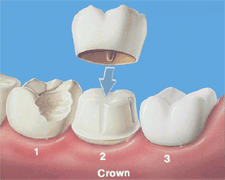المقالات
Worn Fillings

If a small filling wears out, and most of your natural tooth is still intact, it's usually safe to replace it with another filling. But when a large filling wears out, it's often best to switch to a crown. Unlike a filling, a crown covers and protects a damaged tooth.
Your fillings endure an incredible amount of biting force every day, and as they age, they often become worn and weakened. Their appearance and their ability to function degrade. If they crack or become loose, they lose their protective seal, which can lead to decay.
A key factor -- how much of your natural tooth is remaining? When we evaluate a filling that needs replacement, we consider both the size of the filling and the amount of healthy tooth structure that remains. Sometimes, we can replace your filling with another filling, but it will typically be larger than the original. Large fillings weaken your tooth, and leave it more vulnerable to damage; a damaged tooth is much more difficult to repair.
That's why we often recommend a crown when replacing a large worn filling. A crown will strengthen and protect your existing tooth, and help prevent additional damage.
Placing a crown Typically, it takes two appointments to restore your tooth with a crown, because it's custom crafted in a dental laboratory to precisely fit your tooth. After we've made sure the area is completely numb, we remove any decay and shape your tooth. We then take an impression of your teeth, which gives us an accurate working model of your mouth so we can re-create your natural bite.
It will take the dental lab several weeks to create your crown. During this time, you'll have a temporary crown to cover and protect the prepared tooth. At your next visit, we'll remove the temporary crown and place your new custom crown, carefully checking the fit and your bite. When everything looks good, we'll cement it in place and you'll have your new crown.
